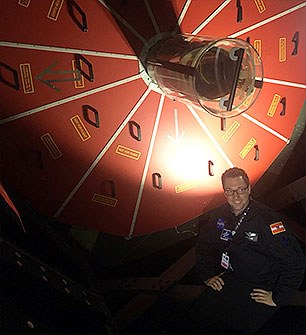SOFIA's 'open-heart surgery'

SOFIA's heart is really sensitive, which is why the doors to it are usually only opened when she is on 'Cloud 9'. At altitudes in excess of 12 kilometres, the air is very clean and there is no danger that the mirror inside SOFIA will become dirty. Any maintenance on the mirror – a thorough cleaning or its installation or removal – brings with it a high risk of damage.
At the heart of the joint NASA and DLR airborne observatory, SOFIA, is a 2.7-metre, 800-kilogram primary mirror made of fragile glass – a custom-made reflector for which there is no replacement. This is why it is only ever handled with 'velvet gloves' and treated like the princess from the fairy tale 'The Princess and the Pea'. Should the mirror break, it would be the end of SOFIA.
Yet the telescope doors have been opened on the ground?
SOFIA will be in Hamburg for a few more days for maintenance work. Last week, the aircraft structure near the telescope doors had to be inspected. To do so, heavy-duty scaffolding was set up around the delicate mirror. This meant that many people were simultaneously working very close to the mirror, which was potentially dangerous for our 'glass eye'.

Of course, protective measures were considered in advance in order to minimise the risk of damage. Covers for the entire mirror system are used whenever maintenance work is performed near the telescope. These covers are placed over all the mirrors' sensitive surfaces. This video of the SOFIA telescope clearly explains how the mirror system works.
For this more complex maintenance work in Hamburg, a large additional tarpaulin was manufactured to surround the entire telescope. This is a fabric cover that encloses and protects the entire mirror system, including the support structure. Air that has been cleaned using a special filter is blown under the tarpaulin. This creates positive pressure under the cover preventing dust or chemical vapours from getting near the mirrors.

Together with other safeguards, the risk can be reduced further. For example, only specially trained personnel have access to the telescope. Nevertheless, the atmosphere was extremely tense during those few days. It was a great relief when the work was successfully completed and the scaffolding could be dismantled.
Once the scaffolding was taken away and the protective cover removed, it was time for the next highlight – examination of an area of the fuselage that is concealed when the telescope doors are closed. For this rare inspection, the telescope doors had to be moved out of the way – or in other words, opened.


All the inspections and repairs were eventually completed successfully. The entire team is pleased to have performed this 'open-heart surgery' and to have been involved in this one-of-a-kind experience. The final phase of the maintenance work is now being performed.
Next week, NASA pilots will carry out the final preparations on the aircraft before taking it for a test flight over the North Sea. If the weather is good, attentive observers will be able to see N747NA over Amsterdam, Rotterdam, Luxemburg and Frankfurt – and especially above Hannover. If all goes well, it will then finally return to sunny California the next day.
Tags:
